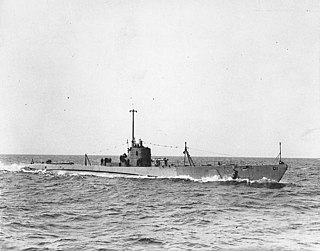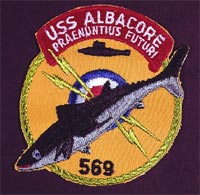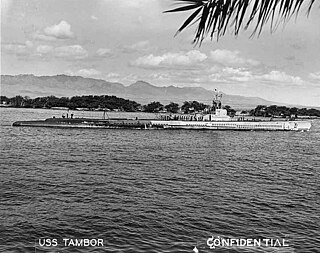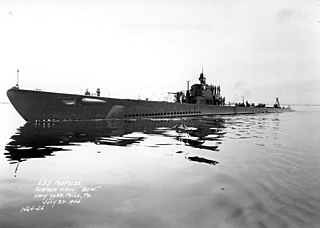
A submarine is a watercraft capable of independent operation underwater. It differs from a submersible, which has more limited underwater capability. The term is also sometimes used historically or colloquially to refer to remotely operated vehicles and robots, as well as medium-sized or smaller vessels, such as the midget submarine and the wet sub. Submarines are referred to as boats rather than ships irrespective of their size.

Project 651, known in the West by its NATO reporting name Juliett class, was a class of Soviet diesel-electric submarines armed with cruise missiles. They were designed in the late 1950s to provide the Soviet Navy with a nuclear strike capability against targets along the east coast of the United States and enemy combatants. The head of the design team was Abram Samuilovich Kassatsier. They carried four nuclear-capable cruise missiles with a range of approximately 300 nautical miles (560 km), which could be launched while the submarine was surfaced and moving less than four knots (7.4 km/h). Once surfaced, the first missile could be launched in about five minutes; subsequent missiles would follow within about ten seconds each. Initially, the missiles were the inertially-guided P-5. When submarine-launched ballistic missiles rendered the P-5s obsolescent, they were replaced with the P-6 designed to attack aircraft carriers. A special 10 m2 target guidance radar was built into the forward edge of the sail structure, which opened by rotating. One boat was eventually fitted with the Kasatka satellite downlink for targeting information to support P-500 4K-80 "Bazalt" anti-ship cruise missiles. The Juliett class had a low magnetic signature austenitic steel double hull, covered by two inches (51 mm) thick black tiles made of sound-absorbing hard rubber.

The Gato class of submarines were built for the United States Navy and launched in 1941–1943. Named after the lead ship of the class, USS Gato, they were the first mass-production U.S. submarine class of World War II.

USS Dolphin (SF-10/SC-3/SS-169), a submarine and one of the "V-boats", was the sixth ship of the United States Navy to be named for that aquatic mammal. She also bore the name V-7 and the classifications SF-10 and SC-3 prior to her commissioning. She was launched on 6 March 1932 by the Portsmouth Navy Yard, sponsored by Mrs. E.D. Toland, and commissioned on 1 June 1932.

An attack submarine or hunter-killer submarine is a submarine specifically designed for the purpose of attacking and sinking other submarines, surface combatants and merchant vessels. In the Soviet and Russian navies they were and are called "multi-purpose submarines". They are also used to protect friendly surface combatants and missile submarines. Some attack subs are also armed with cruise missiles, increasing the scope of their potential missions to include land targets.

USS Argonaut (V-4/SF-7/SM-1/A-1/APS-1/SS-166) was a submarine of the United States Navy, the first boat to carry the name. Argonaut was laid down as V-4 on 1 May 1925 at Portsmouth Navy Yard. She was launched on 10 November 1927, sponsored by Mrs. Philip Mason Sears, the daughter of Rear Admiral William D. MacDougall, and commissioned on 2 April 1928. Although never officially designated as "SS-166", at some point she displayed this number on her conning tower.

USS Albacore (AGSS-569) is a unique research submarine that pioneered the American version of the teardrop hull form of modern submarines. The revolutionary design was derived from extensive hydrodynamic and wind tunnel testing, with an emphasis on underwater speed and maneuverability. She was the third vessel of the United States Navy to be named for the albacore.

A cruise missile submarine is a submarine that carries and launches cruise missiles as its primary armament. Missiles greatly enhance a warship's ability to attack surface combatants and strike land targets; although torpedoes are a more discrete option for submerged submarines, missiles give a much longer stand-off range, shorter time to impact the target, as well as the ability to engage multiple targets on different headings at the same time. Many cruise missile submarines retain the capability to deploy nuclear warheads on their missiles, but they are considered distinct from ballistic missile submarines due to the substantial differences between the two weapons systems' flight characteristics; cruise missiles fly aerodynamically using flight surfaces like wings or fins, while a ballistic missile uses its engine power alone as it may exit the atmosphere.

USS Tang (SS/AGSS-563), the lead ship of her class, was the second ship of the United States Navy to be named for the tang.

The Greater Underwater Propulsion Power Program (GUPPY) was initiated by the United States Navy after World War II to improve the submerged speed, maneuverability, and endurance of its submarines. (The "Y" in the acronym was added for pronounceability.)

The Balao class was a design of United States Navy submarine used during World War II, and with 120 boats completed, the largest class of submarines in the United States Navy. An improvement on the earlier Gato class, the boats had slight internal differences. The most significant improvement was the use of thicker, higher yield strength steel in the pressure hull skins and frames, which increased their test depth to 400 feet (120 m). Tang actually achieved a depth of 612 ft (187 m) during a test dive, and exceeded that test depth when taking on water in the forward torpedo room while evading a destroyer.

Tench-class submarines were a type of submarine built for the United States Navy (USN) between 1944 and 1951. They were an improvement over the Gato and Balao classes, only about 35 to 40 tons larger, but more strongly built and with a slightly improved internal layout. One of the ballast tanks was converted to carry fuel, increasing range from 11,000 nautical miles to 16,000 nautical miles. This improvement was also made on some boats of the previous two classes. Further improvements were made beginning with SS-435, which are sometimes referred to as the Corsair class. Initial plans called for 80 to be built, but 51 were cancelled in 1944 and 1945 when it became apparent that they would not be needed to defeat Japan. The remaining 29 were commissioned between October 1944 (Tench) and February 1951 (Grenadier). The last submarine of the Tench class, as well as the last submarine which served during World War II, remaining in service with the U.S. Navy was USS Tigrone (AGSS-419) which was decommissioned on 27 June 1975.

The Skate-class submarines were the United States Navy's first production run of nuclear-powered submarines. They were an evolution of the Tang class in everything except their propulsion plants, which were based on the operational prototype USS Nautilus. The four Skate class boats re-introduced stern torpedo tubes. Although among the smallest nuclear-powered attack submarines ever built, the Skate class served for many years, with the last being decommissioned in 1989. USS Skate was the first submarine to surface at the North Pole, on 17 March 1959.

The V-boats were a group of nine United States Navy submarines built between World War I and World War II from 1921 to 1934 under authorization as the "fleet boat" program.

The Tambor-class submarine was a United States Navy submarine design, used primarily during World War II. They were the USN's first fully successful fleet submarine, and began the war close to the fighting. Six of the class were in Hawaiian waters or the Central Pacific on 7 December 1941, with Tautog at Pearl Harbor during the attack. They went on to see hard service; seven of the twelve boats in the class were sunk before the survivors were withdrawn from front-line service in early 1945; this was the highest percentage lost of any US submarine class. Tautog was credited with sinking 26 ships, the largest number of ships sunk by a US submarine in World War II. The Tambors attained the top speed of 21 knots (39 km/h) and range of 11,000 nautical miles (20,000 km) of the preceding Sargo class, and improvements included six bow torpedo tubes, a more reliable full diesel-electric propulsion plant, and improved combat efficiency with key personnel and equipment relocated to the conning tower. In some references, the Tambors are called the "T Class", and SS-206 through SS-211 are sometimes called the "Gar class".

The Sargo-class submarines were among the first United States submarines to be sent into action after the Japanese attack on Pearl Harbor, starting war patrols the day after the attack, having been deployed to the Philippines in late 1941. Similar to the previous Salmon class, they were built between 1937 and 1939. With a top speed of 21 knots, a range of 11,000 nautical miles (20,000 km), and a reliable propulsion plant, along with the Salmons they were an important step in the development of a true fleet submarine. In some references, the Salmons and Sargos are called the "New S Class", 1st and 2nd Groups.

The United States Navy Salmon-class submarines were an important developmental step in the design of the "fleet submarine" concept during the 1930s. An incremental improvement over the previous Porpoise class, they were the first US submarine class to achieve 21 knots with a reliable propulsion plant, allowing them to operate with the Standard-type battleships of the surface fleet. Also, their 11,000 nautical miles (20,000 km) unrefueled range would allow them to operate in Japanese home waters. These rugged and dependable boats provided yeoman service during World War II, along with their immediate successors, the similar Sargo class. In some references, the Salmons and Sargos are called the "New S Class", 1st and 2nd Groups.

The Porpoise class were submarines built for the United States Navy in the late 1930s, and incorporated a number of modern features that would make them the basis for subsequent Salmon, Sargo, Tambor, Gato, Balao, and Tench classes. In some references, the Porpoises are called the "P" class.
Air-independent propulsion (AIP), or air-independent power, is any marine propulsion technology that allows a non-nuclear submarine to operate without access to atmospheric oxygen. AIP can augment or replace the diesel-electric propulsion system of non-nuclear vessels.

The Sjöormen class was a class of submarines built for the Swedish Navy in the late 1960s. They had a teardrop hull shape and were capable of diving to 150 metres (490 ft). At the time of their deployment they were regarded as one of the most advanced non-nuclear submarine-classes in the world, incorporating many new features including x-rudder and anechoic tiles. Both speed and underwater endurance was at this time very high for a conventional submarine. The submarines were retired by Sweden in the early 1990s. In the late 1990s, four submarines were acquired by the Republic of Singapore Navy (RSN) and relaunched as the Challenger class following modernisation and tropicalisation.



















